
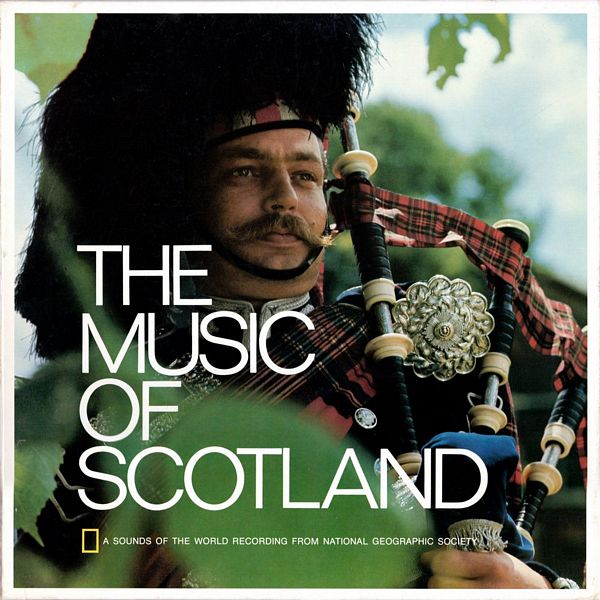 |
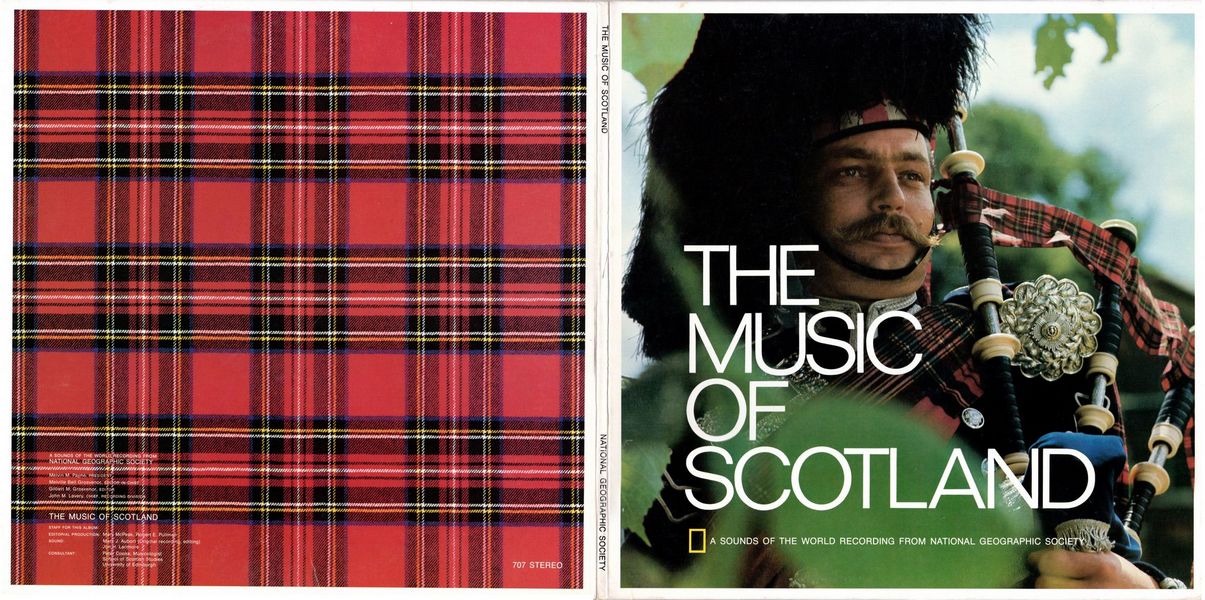
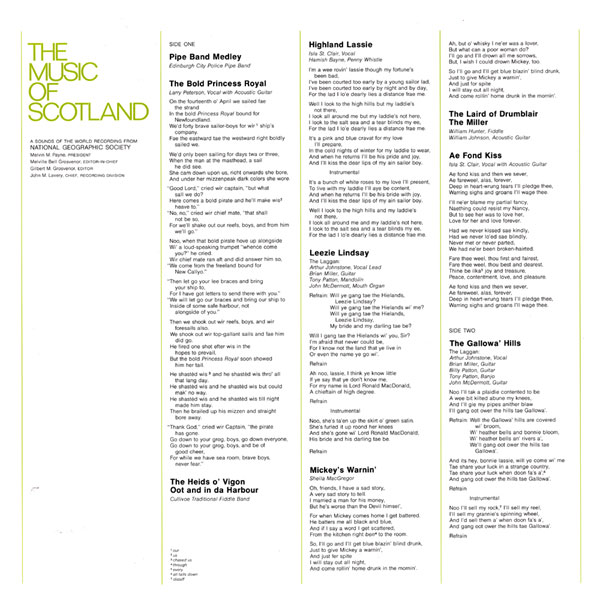
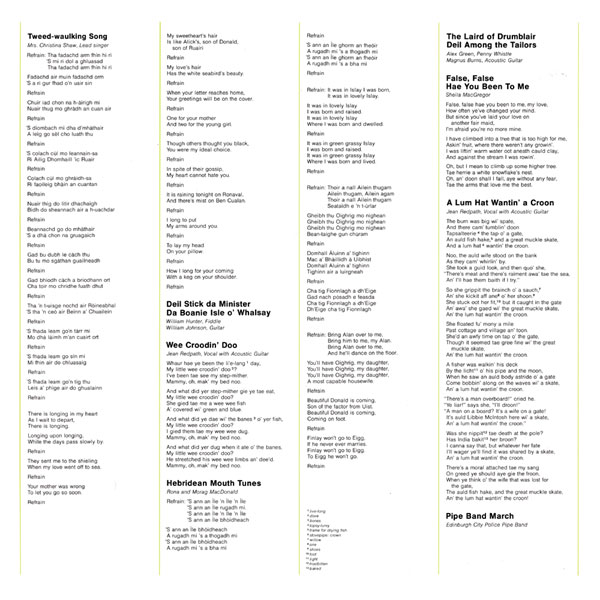 |
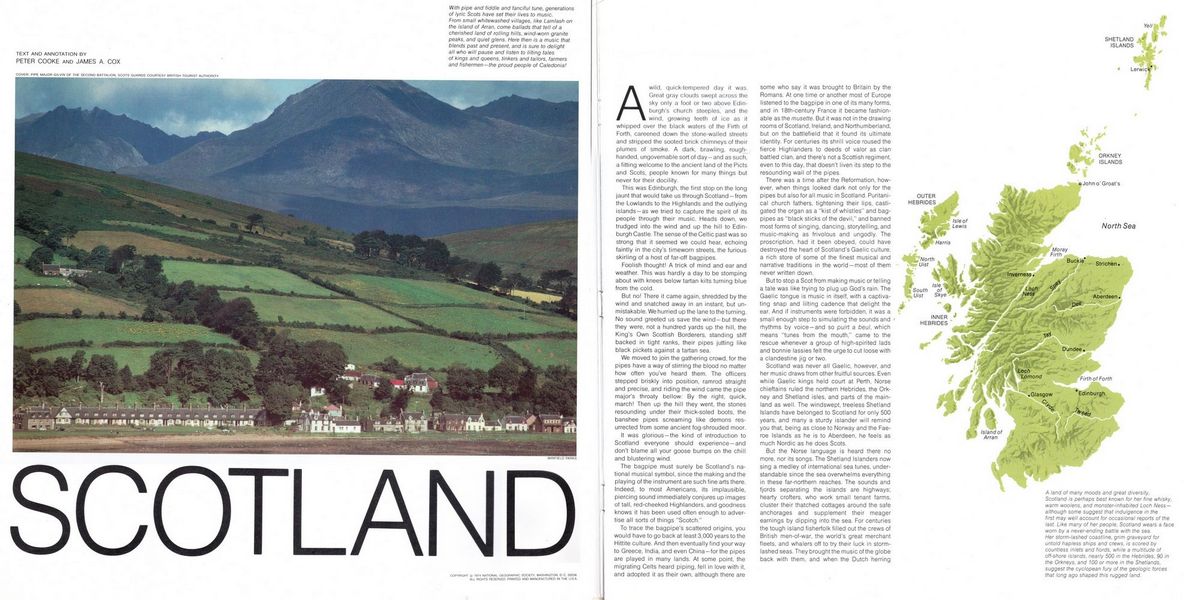
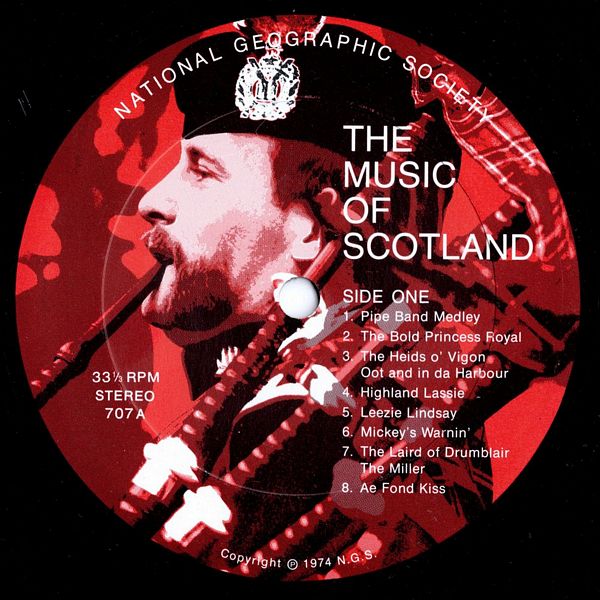
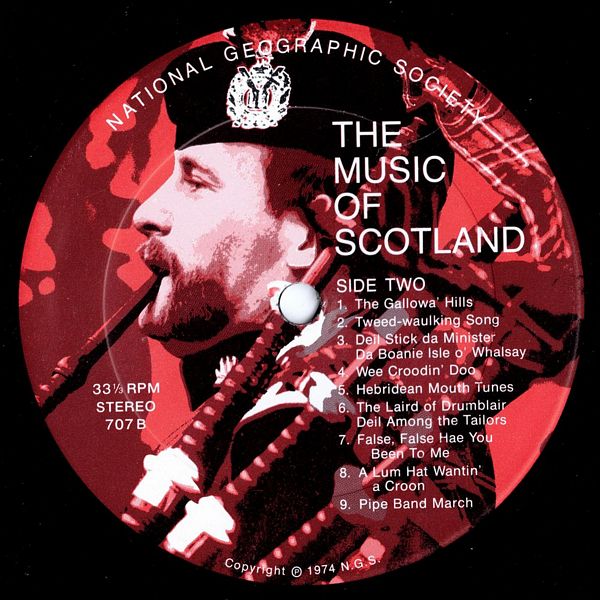
|
Sleeve Notes
PIPE BAND MEDLEY
On hand to start off the proceedings in the proper Scottish spirit is the Edinburgh City Police Pipe Band with a lively medley beginning with a slow air and followed by traditional strathspeys and reels — "Mrs. Joy Cairns," "Stumpie," "The Duke of Gordon," "Deil Among the Tailors," and "Circassian Circle." Four times winner of the World Pipe Band Championship since John MacLeod took over as pipe major in 1959, the band carries on a proud tradition that began almost 500 years ago.
In 1487 four town musicians — three public "pypers," who played fifes, not bagpipes — and a drummer were employed to march through the streets of Edinburgh at dawn and again in the evening. By the middle of the 17th century the marchers had become a band of "waits," playing cornets and sackbuts (the old name for trombones), who also gave a recital at noon each day. The police band took over the duties of the old city band in 1890, and has been a familiar sight in the city streets ever since, especial ly at festival time, when the sturdy pipers and drummers step out in swinging kilts bearing the tartan of Charles Edward Stuart, the Bonnie Prince himself.
The music here is made by the "small band" — just six pipers and four drummers from the complete band. Imagine what must have been a deafening gale of sound when Prince Charlie marched victorious into Edinburgh from the battle at Prestonpans in 1745 to the triumphant skirling of 100 pipers! It's no wonder the British, after the final defeat of the Highland clans at bloody Culloden, outlawed the playing of the piob mór, the great pipes, for an entire generation.
THE BOLD PRINCESS ROYAL
Going off to sea was the lot of many a Shetland Islander — some by choice, when the fishing ran poor, but many in the rough grasp of press gangs or in chains to serve their time aboard naval vessels. The despised and feared press gangs descended on some islands so often that the inhabitants built their cottages on the highest ground available, a vantage point which suffered from the wintry gales that swept across the treeless land but afforded a clear view in all directions — and ample time to sound the warning when unwelcome visitors approached.
Playing his acoustic guitar, Larry Peterson sings a Shetland-dialect version of this famous old forecastle ballad, a reminder of the rough-and-tumble days of sail when press gangs, shipwrecks, smuggling, and piracy were all part of life for the men who followed the sea.
THE HEIDS O' VIGON OOT AND IN DA HARBOUR
A good tune doesn't have to be home grown to be appreciated — and appropriated — in the Shetland Islands. "Oot and in da Harbour" is a traditional island reel, but "The Heids O' Vigon" has a more romantic origin. Many years ago a shipwrecked sailor, washed ashore under the Vigon cliffs up in the northwest corner of Yell, had to wait for a month or so until the weather improved enough for him to catch passage back south. He whiled away the time by teaching his hosts a favorite pipe march, and they promptly converted it into a lively reel, naming it after the headlands where they found him.
Both airs are played here by the Cullivoe Traditional Fiddle Band of Yell, a group that spans three generations now, with Gordon and Victor Jamieson vamping out an accompaniment on electric guitars as "Grandad" Bobby and his friends play away on their treasured fiddles.
HIGHLAND LASSIE
Isla St. Clair has a special way with songs such as this, for she was brought up among fisherfolk in the busy little port of Buckie, just 50 miles east of Inverness, the Highland "capital." Despite the lighthearted melody and the spirited whistleplaying by Isla's husband, Hamish Bayne, the lyrics serve as a poignant reminder that life for wives, sweethearts, and mothers on the rocky northeast coast is often filled with moments of quiet desperation. When the wintry gales come roaring in, they can do nothing but watch, wait, and pray that their menfolk will come home safely.
Songs like this never die — even though few of them are committed to paper and bound in hard-covered books — for as long as men go down to the sea there will be women waiting anxiously for their return, knowing in their hearts that happiness and grief are but a breath apart.
LEEZIE LINDSAY
A century or two ago, the prowess of Highlanders as lovers was legendary, and any number of romantic ballads and tales were spun of lovely Lowland girls swept off their feet by the charms of Highland laddies. High-handed Highland laddies, as it turned out, for often enough the lass in the story was kidnapped and forced into wedlock at gunpoint — which is how Rob Roy, the famous outlaw, acquired a wife.
This variation on an old theme, a fine swinging tune is rendered by five young Glaswegians who call themselves "The Laggan." In it, Lord Ronald MacDonald acknowledges to Leezie Lindsay that he is "a chieftain of high degree." In other versions he comes disguised as a poor crofter, and even when he gets Leezie back home, footsore and weary, he keeps up the pretense of poverty by making her spend their first night together on a bed of green rushes in a miserable hovel outside his fine mansion, then adds insult to injury by waking her at the crack of dawn to go out and milk the kye.
Years later, after that fateful day in 1746 when dark Culloden Moor ran red with the blood of young Highlanders, Bonnie Prince Charlie himself got woven into the fabric of these ballads, becoming the storied Highland chieftain for all those with affection for the Jacobite cause.
MICKEY'S WARNIN'
On a clear day the coast of the Emerald Isle can be seen across the waters of the North Channel from Kintyre and the Rhinns of Galloway, a reminder that the Gaels came from there so many centuries before, speaking a language that was still referred to as "Irish" a thousand years later. The bonds between the two peoples still run strong, especially in music. Irish harpers — Rory O'Kane and Carolan and the like — often paid visits to the big country houses of the Highland aristocracy to weave the magic spell of their sweet ballads. And members of the Scottish tinsmith clans, the "traveling folk," frequently journeyed westward, and still do, to find seasonal work in Ireland, taking their songs with them and bringing others back.
It was in Ireland that Sheila MacGregor, then a young girl and traveling about the land as gypsies will, came across this bittersweet song which has its roots in the domestic comedy of the latter-day Irish music hall — but also has enough of true life in it to have caught the fancy of more than one wandering troubadour.
THE LAIRD OF DRUMBLAIR THE MILLER
Willy Hunter works as the manager of a knitting mill in Lerwick, in the Shetland Islands. But when he puts aside his commercial cares and takes fiddle in hand, he plays in a manner that many a concert violinist would envy. Here he is joined by his friend guitarist William Johnson in playing two bouncy tunes, the first a strathspey, the second a hornpipe.
While hornpipes are fairly familiar fare, the strathspey is somewhat unique. Literally, the word means "valley of the Spey," the Spey being a river clear as crystal that tumbles from its source in the bleak Grampian Mountains and is still running briskly as it debouches into the North Sea a few miles west of Buckie. Until recently one of the last remaining Gaelic-speaking areas of the northeast, the valley of the Spey is noted for its fine malt whiskies, its talented fiddlers, and the sprightly dance to which it gave its name — a musical form highlighting the rhythm known as "Scotch snap," which has its roots in the Gaelic tongue itself.
Each year in Elgin, the chief town of the area, fiddlers come from miles around to vie for honor and prizes. "Young Willie" Hunter has taken his share of awards, even though he is a Shetlander who still lives in those blustery northern isles — which just goes to prove, the local folk will admit with disarming smiles, that in rare cases a fiddler doesn't have to be born in Strathspey to play like a Speysider.
AE FOND KISS
Ae fond kiss and then we sever,
Ae fareweel, alas for ever,
Deep in heart-wrung tears I'll pledge thee
Warring sighs and groans I'll wage thee —
What could be better than an impassioned love lyric by Robbie Burns — and one with a touch of mystery about it, to boot? Burns penned these lines for Agnes Maclehose a few hours before that dark, vivacious lady left Edinburgh in an attempt to rejoin her estranged husband in Jamaica. The mystery? The relationship of poet and lady was a tantalizing one, for the many letters which flowed between them abound in passionate phrases — yet all other evidence points to a love affair that was purely platonic. Perhaps it would be like a poet to pour his heart into words, and then present them to the one he loved so that she, in turn, could make a gift of them to someone else.
When he wrote the poem, Burns had in mind an air by Rory Dali — Blind Rory O'Kane — one of the last of the old Irish harpers. The tune never caught on, however, and the melody given it here was substituted. It is supposed to be an old Gaelic air, and although this is doubtful, it fits the lyric well whatever its origin — especially when lovely Isla St. Clair sings it to her own gentle guitar accompaniment.
THE GALLOWA' HILLS
The traveling folk have a song for every part of Scotland, even the rolling green moors of Galloway, usually passed unnoticed by those heading north after crossing Hadrian's Wall, the old Roman boundary that was supposed to keep the warlike Picts and Scots safely isolated in their own domain.
"We got this from Jeannie hersel','' say the boys of The Laggan, referring to Jeannie Robertson, long hailed as Scotland's greatest folk singer. Jeannie's own people, travelers all, may have "pickit up" the song in this mild southwestern corner of Scotland, for it derives from one made by the old-time Galloway minstrel-poet, "Wandering Willie" Nicholson, himself a follower of the packman's free and easy life.
The sentiments of the song, celebrating the beauty of the "Gallowa' Hills," find welcome lodging not only in the hearts of rural folk; Clyde-siders in grimy Glasgow, be they shop stewards, painters, or even students knocking out a tune together in a waterfront pub, can get as misty-eyed over music as anyone.
TWEED-WAULKING SONG
Much of the world's finest tweed is woven in the tiny croft houses that dot the stony landscape of Harris, so cut off from neighboring Lewis by wild mountains that it calls itself a separate island. In earlier days it was the custom to call on one's friends, especially the good singers, to help finish the new cloth — that is, to soak it and pound it for hours at the "waulking board" to shrink it to a soft, closely matted texture. As a result, a marvelous literature of songs came into being over the centuries, as the women who labored for long hours over the waulking board harnessed their poetic and musical talents to the rhythm of the work.
And the texts of the songs? Why, love, and the amorous adventures of aristocratic clansmen, of course! For men were rarely allowed in during the tweed-waulking sessions, and it was perfectly acceptable to sing their praises — just so long as they could not hear.
Some weavers still waulk their own tweed rather than send it north to a factory at Stornoway for finishing, but not often these days can they gather a team of workers and singers such as the one led here by Christina Shaw. Although she is in her sixties, Christina still commands great respect for her wide repertoire and the marvelously bright, jewel-hard timbre of her voice. Soaring out over the rhythmic thump of strong arms plying their skill at the waulking board, it represents all the best in Harris singing.
DEIL STICK THE MINISTER DA BOANIE ISLE O' WHALSAY
Up until World War I, the Shetland reel was by far the most popular dance in the northern isles, for its steps were admirably suited to the cramped floor space in the average croft kitchen. Other dances have come along since, but this three-couple reel still has a special role at weddings. On Fetlar Isle, for instance, the newlyweds, the best man and maid, and the "married folk" lead off the dancing, but the groom isn't allowed to partner his blushing bride until the fiddler strikes up the third of three reels, played to the air of "Lassie, Is the Bed Made?" This is perhaps a reminder of an even older ritual, wherein the bride was ceremoniously undressed and ensconced in the nuptial bed by her friends, while a fiddler — certainly an old man — sat in a corner lilting out a tune for "bedding the bride."
In modern English, the title of this lively reel means "Devil Beat the Minister," as likely as not some irate fiddler's reaction to the old kirk ban on dance music and the singing of "vain" songs. Accompanied by William Johnson on guitar, it is played here by "Young Willy" Hunter in the Shetlands style taught him by his father, the island blacksmith, who at 70 is still supple enough to turn a good "spring" or two.
WEE CROODIN' DOO
This fine old ballad tells of a young nobleman named Lord Randal, or Ronald, or Tiranto, or Henry, who is poisoned by his sweetheart, or his sister, or his stepmother. What seems like confusion really isn't; it depends upon which variation you know, for many European countries count a version or two of the song in their music.
Jean Redpath learned her sad gentle ‘‘Wee Croodin' Doo" from her parents, who live in Leven on the east coast in the mining county of Fife. Here the ballad has become a lullaby, with the young nobleman reduced to a very small lad, as sweet as a wee cooing dove.
HEBRIDEAN MOUTH TUNES
The natural snap and rhythm of the Gaelic tongue in concert with a delight in lighthearted wordplay has produced over the years a large collection of vocal dancing tunes called puirt a beul — literally, "tunes from the mouth." This is but one example of the great tradition of unaccompanied singing, in which the Scots excel, and it's a rare ceilidh that doesn't include at least one mouth tune to set the dancers spinning.
The first one presented here by Rona and Morag MacDonald is called "S' ann a Niall." In sprightly strathspey rhythm it praises lovely Islay, that jewel of the Inner Hebrides. The second, "Thoir an nall," is in reel time, and comes from Rona and Morag's own Uist. Quite a tongue-twister — which is half the fun of mouth tunes — it must have caused many a sly smile in its time, for it is filled with wry humor about the young men in a certain wedding party.
Rona and Morag belong to a Uist family renowned not only for its store of wonderful old mouth tunes but for its pipers — Rona herself is the champion woman piper of all Scotland!
THE LAIRD OF DRUMBLAIR DEIL AMONG THE TAILORS
Although the tin whistle is associated primarily with Ireland, it also has its fans in Scotland. In fact, to the musical Scot any instrument is acceptable — pictures of 19th century "bothy" bands (a bothy was a rough stone structure used to house unmarried farmhands) show fiddles, pipes, whistles, concertinas, and melodeons of all shapes and sizes. Even the tiny "trump," or jew's harp, was pressed into service when nothing else was available.
In this version of the old reel, "DeiI Among the Tailors," a title that refers to a British table-skittles game, Alex Green of Aberdeen plays the penny whistle with virtuoso skill, accompanied by Magnus Burns on the guitar.
FALSE, FALSE HAE YOU BEEN TO ME
Visit an encampment of tinkers, Scotland's gypsy traveling folk, and with a little luck, when night falls, you will find yourself sitting in the warm glow of a campfire, listening raptly to a seemingly endless succession of old songs, tales, and legends. A long oral tradition has given these talented and friendly wanderers memories saturated with the lore and literature of the past, even those who, like Sheila MacGregor's people, now live more settled lives near the berry fields of Blairgowie.
Songs of jilted lovers are found throughout Scottish tradition, but few can match the haunting melody and rich imagery of this soliloquy, given to Sheila by her mother, who learned it herself as a wee girl at the knee of her old "Grannie" MacGregor.
A LUM HAT WANTIN' A CROON
Physician David Rorie wrote this fine tune late in the last century "one fine summer night... in an English manufacturing town, where the mere thought of a Highland burn in spate was as an ice-cold draught in a parched land." The song passed into the oral tradition before the ink was barely dry, for during the Ladysmith campaign in the Boer War it seemed that everyone in the ranks was whistling it. The popularity of the air lasted from that war to the next, for its whimsical humor and cheery marching lilt made it a favorite of Scots troopers in World War I.
David Rorie was neither the first nor the last to try his hand at writing in Lallans, the old "braid-Scots" dialect. Other young poets, in modern times as well as back in the days of Robbie Burns, found in it a means of asserting their national identity, not to mention scoring over the Sassenachs, their English neighbors who find the language difficult to understand.
Jean Redpath, who sings and plays it here, learned it from her grandfather, who must have heard it only a year or two after Rorie wrote it. Jean's version, based on her grandfather's memory, differs from the printed poem in parts, but that's the essence of oral tradition, when songs are made and remade until they take on the patina of fine silver.
PIPE BAND MARCH
There's no more fitting way to end our musical interlude in Scotland than by listening to the Edinburgh City Police Pipe Band march off, kilts swinging, drums rattling and pipes pealing, to the rousing strains of "The Hills of Perth," a stirring retreat march.
Hardly a hill or glen in Scotland has not had a tune written about it to commemorate some event in the country's turbulent history, but little is known of the origin of this march. Nonetheless, it is one of the finest of many which served to inspire the troops on long, hot marches, or at the height of battle. Even in peacetime, hearing it stirs something in the blood of all proud folk who call themselves Scots.
If there happens to be a drop of Scots blood in you, we'll have accomplished what we set out to do if you felt it drumming in your ears at some time during your brief visit to our ceilidh.